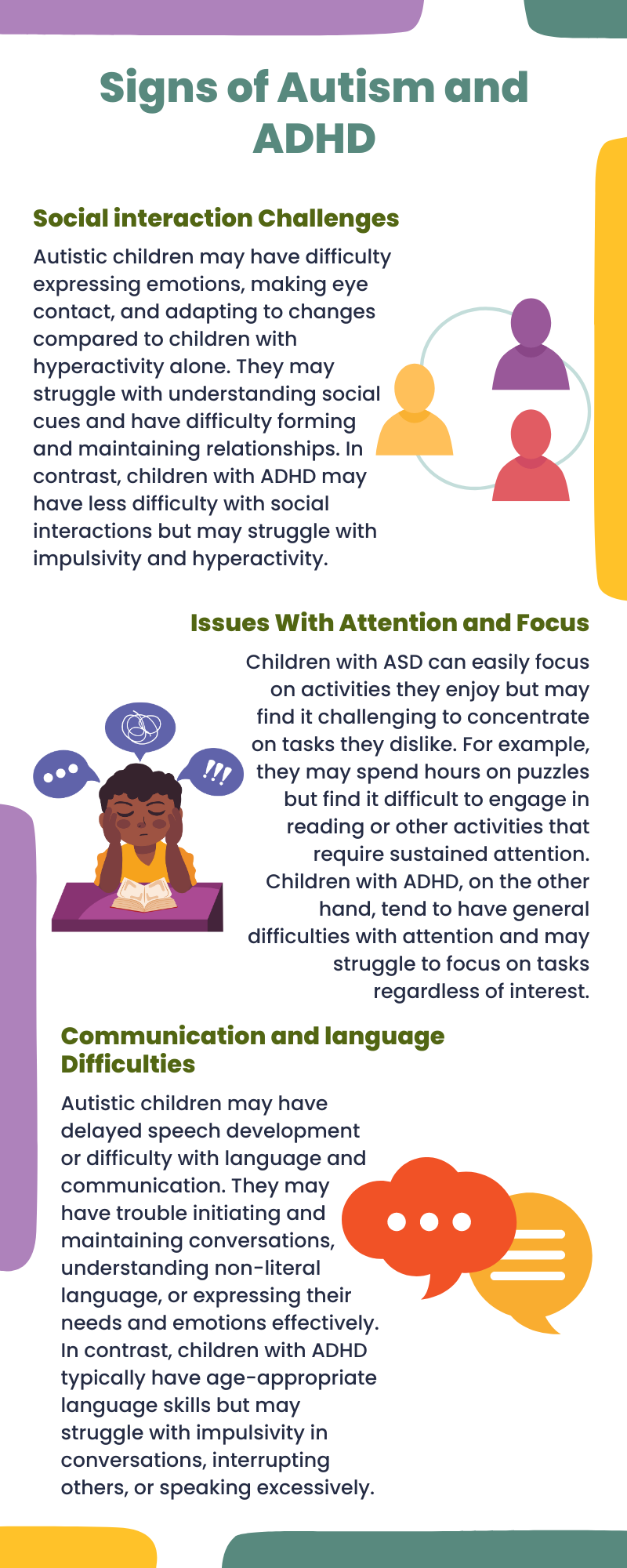Autism and hyperactivity are two interconnected conditions that can significantly impact individuals’ lives. By exploring the link between autism and ADHD and understanding the genetic factors involved, we can gain a deeper understanding of these complex conditions.

The Link Between Autism and ADHD
There is a significant overlap between autism and ADHD, with many individuals having characteristics of both conditions. Studies have shown that an estimated 22% to 83% of autistic children meet the criteria for ADHD, and conversely, 30% to 65% of children with ADHD have significant autistic traits. This suggests that there may be shared underlying factors contributing to the development of both conditions.
While autism and ADHD are distinct disorders, they share some common features such as difficulties with attention, impulse control, and social interaction. However, it’s important to note that the specific symptoms and severity can vary widely among individuals.

Genetic Factors in Autism and ADHD
Both autism and ADHD are believed to involve multiple genes, but the specific genes and genetic mechanisms involved can differ from person to person. Researchers have identified several genes that may contribute to the development of these conditions. However, it’s important to note that genetics is just one piece of the puzzle, and environmental factors also play a role in their manifestation.
Understanding the genetic factors in autism and ADHD can help researchers and healthcare professionals develop targeted interventions and treatments. By identifying the specific genetic variations associated with these conditions, it may be possible to develop personalized approaches to support individuals with autism and ADHD.
While genetics plays a significant role in autism and ADHD, it’s important to remember that these conditions are complex and multifaceted. Environmental factors, such as prenatal exposure to certain substances or maternal health, may also contribute to the development of these conditions.
Behavioral Patterns and Risks
Understanding the behavioral patterns and associated risks in individuals with autism and hyperactivity is crucial for providing appropriate support and intervention. Let’s explore the coping mechanisms commonly observed in autistic and ADHD individuals, as well as the risk factors for anxiety and depression.
Coping Mechanisms in Autistic and ADHD Individuals
Both autistic individuals and those with ADHD develop coping mechanisms to navigate their daily lives. However, these coping mechanisms differ due to the distinct characteristics of each condition.
Autistic individuals often rely on self-regulation techniques to manage sensory overload and emotional challenges. These techniques may include engaging in repetitive behaviors, using tools like fidget toys, or seeking a quiet and familiar environment. These strategies help autistic individuals create a sense of predictability and comfort, enabling them to cope with the demands of their surroundings.
On the other hand, individuals with ADHD may exhibit coping mechanisms such as fidgeting, tapping, or constantly moving to help maintain focus and manage restlessness. These behaviors provide sensory stimulation and can assist in reducing hyperactivity and impulsivity. However, it’s important to note that these coping mechanisms may vary among individuals and can change over time.
Risk Factors for Anxiety and Depression
Autistic individuals and those with ADHD are at a higher risk for anxiety and depression compared to the general population. The challenges they face in social interactions, communication, and sensory processing can contribute to these mental health conditions.
Autistic individuals may experience anxiety due to difficulties in understanding social cues, interpreting nonverbal communication, or navigating unpredictable situations. They may also struggle with expressing their emotions and adapting to changes, which can lead to increased anxiety levels.
Individuals with ADHD may also face challenges in social settings, but in different ways. They may have difficulty with impulse control, maintaining attention in conversations, and may often interrupt or speak out of turn. These difficulties can result in feelings of frustration, rejection, or isolation, potentially leading to anxiety or depression.
It is important to address these risks by providing appropriate support and intervention. Early identification of symptoms and access to mental health services can play a crucial role in managing anxiety and depression in individuals with autism and hyperactivity.

Social Challenges and Differences
Individuals with autism and hyperactivity face unique social challenges and exhibit different social impacts. Understanding these differences is crucial in providing appropriate support and fostering positive social interactions. In this section, we will explore the social interaction difficulties experienced by individuals with autism and the varied social impacts of both autism and ADHD.
Social Interaction Difficulties
Autistic individuals and those with ADHD encounter difficulties in social settings, albeit in different ways. Autistic individuals may struggle with picking up on subtle body language cues or understanding vague speech, which can hinder their ability to interpret social situations accurately. They may find it challenging to initiate and maintain conversations, express emotions, and make eye contact. These difficulties can make it harder for them to form and maintain relationships.
On the other hand, individuals with ADHD may struggle with impulse control and maintaining attention during conversations. They may interrupt others frequently, struggle to take turns, or have difficulty staying focused on the topic at hand. These challenges can impact social interactions and lead to misunderstandings or difficulties in building relationships.
Varied Social Impacts of Autism and ADHD
The social impacts of autism and ADHD can differ due to the distinct characteristics of each condition. Children with autism spectrum disorder (ASD) may exhibit symptoms such as difficulty with social interactions, unresponsiveness to people, intense staring at objects, and becoming withdrawn and unwilling to engage with others. They may have more difficulty expressing emotions, making eye contact, and adapting to changes compared to children with hyperactivity alone.
Autistic children often have unique interests and may talk at length about subjects they like, sometimes without considering the listener’s level of interest. They may also exhibit aversion to changes in routines or preferences. These differences in social behavior and communication can result in social isolation or challenges in school and community settings.
In contrast, children with attention deficit hyperactivity disorder (ADHD) may experience social challenges related to their impulsivity, hyperactivity, and inattention. They may struggle to control their impulses, leading to impulsive comments or actions that can impact their relationships with peers. Additionally, their difficulty with sustained attention can make it challenging to engage in conversations or participate in group activities effectively.
Understanding these varied social impacts is essential for creating inclusive environments and implementing appropriate strategies to support individuals with autism and hyperactivity in social settings. By providing tailored support and promoting understanding, we can help individuals with these conditions navigate social interactions more effectively and foster meaningful connections.

Diagnosis and Symptoms
When it comes to addressing autism and hyperactivity, early diagnosis and recognition of symptoms are crucial for providing appropriate support and intervention. In this section, we will explore the early signs of ADHD and autism, as well as how to recognize symptoms in children.
Early Signs of ADHD and Autism
In ADHD, symptoms such as hyperactivity and impulsivity are often noticeable by age 7, while attention deficits may become more evident when the child reaches elementary school. These signs may include:
- Difficulty staying seated or remaining still
- Excessive fidgeting or restlessness
- Constantly being “on the go” or running and climbing excessively
- Difficulty waiting for their turn
- Talking excessively or interrupting others
- Forgetfulness and being easily distracted
On the other hand, autism spectrum disorder (ASD) can present early signs that are distinct from ADHD. These signs may include:
- Delayed or limited speech development
- Difficulty with social interactions and communication
- Repetitive behaviors or movements, such as hand-flapping or rocking
- Sensory sensitivities, such as being bothered by certain sounds or textures
- Fixation on specific topics or objects
- Difficulty with changes in routines or preferences
Recognizing Symptoms in Children
Recognizing the symptoms of autism and ADHD in children can be challenging, as some behaviors may be attributed to typical childhood development. However, certain patterns and behaviors may indicate the presence of these conditions. It is important to consult with healthcare professionals for a comprehensive evaluation and diagnosis.
When observing children, it is essential to look for consistent patterns of behavior across different settings and situations. Here are some signs that may indicate the presence of autism or ADHD:

It is important to remember that each child is unique, and symptoms can vary. If you suspect that your child may be exhibiting signs of autism or ADHD, it is recommended to consult with a healthcare professional or specialist who can conduct a thorough evaluation and provide appropriate guidance. Early identification and intervention can make a significant difference in supporting the development and well-being of children with autism and hyperactivity.
Management and Treatment
When it comes to addressing autism and hyperactivity, proactive management and timely intervention play crucial roles in supporting individuals with these conditions. While there is no cure for autism or hyperactivity, various strategies can help manage symptoms and improve overall well-being.
Neuroprotective Approaches
Neuroprotective approaches focus on promoting brain health and minimizing potential damage. These approaches aim to create an environment that supports optimal brain development and function for individuals with autism and hyperactivity.
One important aspect of neuroprotective approaches is early intervention. Identifying and addressing symptoms at an early age can lead to better outcomes in terms of behavioral and cognitive development. This includes implementing individualized therapies and interventions tailored to the specific needs of the individual.
Another important consideration is the overall lifestyle and environment. Providing a structured and supportive environment, along with consistent routines, can help individuals with autism and hyperactivity thrive. Creating a sensory-friendly space and incorporating autism self-regulation techniques can also contribute to managing hyperactivity and promoting self-calming.
Additionally, nutritional support and a balanced diet can play a role in supporting brain health. Some studies suggest that certain dietary changes and supplementation may have a positive impact on symptoms. However, it is important to consult with a healthcare professional or a registered dietitian before making any significant dietary changes.

Importance of Timely Intervention
Timely intervention is crucial in managing autism and hyperactivity. Early identification and diagnosis allow for the implementation of appropriate therapies and interventions when the brain is most receptive to change. Early intervention can help improve communication skills, social interactions, and cognitive abilities.
A comprehensive medical evaluation is essential to identify or rule out other causes of learning disabilities and to determine the appropriate course of treatment. This evaluation may include family history assessments, neurological exams, and advanced neuropsychological testing.
In addition to early intervention, ongoing support and therapy are also important. This may include behavioral therapy, speech therapy, occupational therapy, and social skills training. These interventions are tailored to the specific needs of the individual and focus on improving communication, behavior management, and social interactions.
It is important to note that every individual with autism and hyperactivity is unique, and what works for one person may not work for another. A multidisciplinary approach involving healthcare professionals, educators, and caregivers is crucial in developing an individualized treatment plan. Moreover, it’s important to stay informed about the latest research and therapies to ensure the best possible outcomes for individuals with these conditions.
Research continues to shed light on the neurological basis of sensory issues in autism, offering hope for more targeted and effective therapies in the future. By recognizing and addressing sensory processing difficulties, we can improve the quality of life for individuals with autism and their families. If you’re seeking specialized ABA therapy in New Jersey, Indiana, Georgia, and New York, Golden Care offers comprehensive services tailored to meet the unique needs of each individual. Contact us to learn more or book a consultation today.
Sources:
https://vivereclinic.com/en/gyperaktyvnost-pry-ras.html
https://www.latimes.com/california/newsletter/2023-04-25/adhd-and-autism-group-therapy


